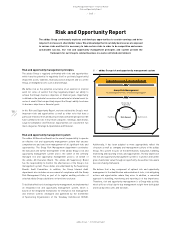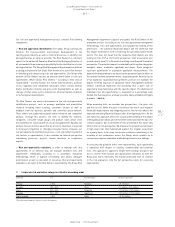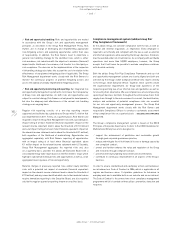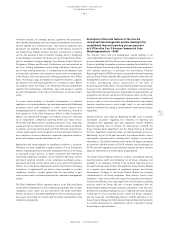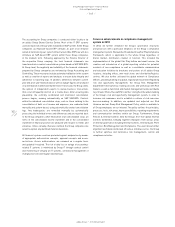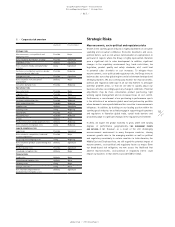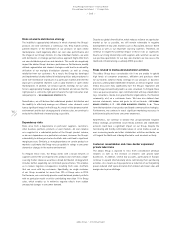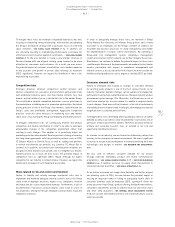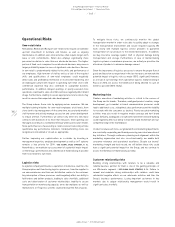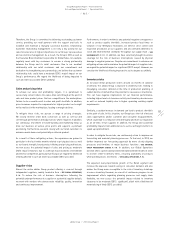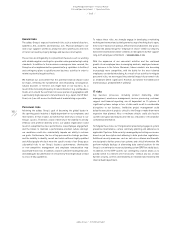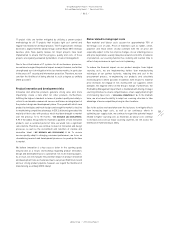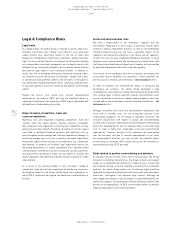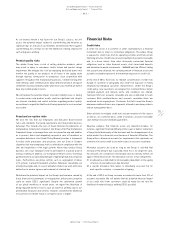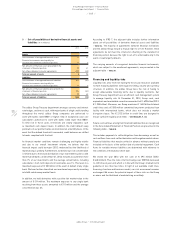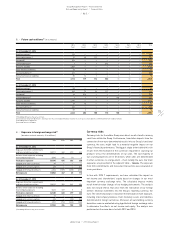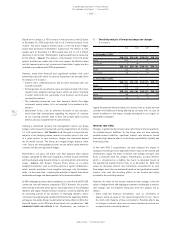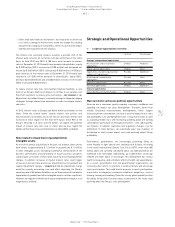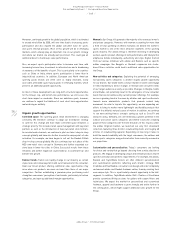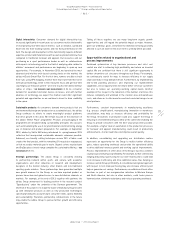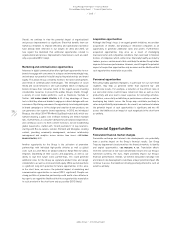Reebok 2013 Annual Report Download - page 172
Download and view the complete annual report
Please find page 172 of the 2013 Reebok annual report below. You can navigate through the pages in the report by either clicking on the pages listed below, or by using the keyword search tool below to find specific information within the annual report.
adidas Group
/
2013 Annual Report
Group Management Report – Financial Review
168
2013
/
03.5
/
Risk and Opportunity Report
/
Operational Risks
Hazard risks
The adidas Group is exposed to external risks such as natural disasters,
epidemics, fire, accidents and malicious acts. Physical damage to our
own or our suppliers’ premises, production units, warehouses and stock
in transit can lead to property damage and business interruption.
These risks are mitigated by loss prevention measures such as working
with reliable suppliers and logistics providers who guarantee high safety
standards. In addition to the insurance coverage we have secured, the
Group has also implemented loss prevention (e.g. sprinklers in facilities)
and contingency plans to quickly recover business activities in order to
minimise potential negative effects.
We maintain our assessment that the potential financial impact could
be major, reflecting the fundamental and devastating consequences
natural disasters or terrorist acts might have on our business. As a
result of the increasing frequency of natural disasters (e.g. earthquakes,
floods, etc.) around the world and since we operate in geographies with
a particularly high exposure to natural hazards (e.g. Japan, the US West
Coast, etc.), we still assess the likelihood of materialising as possible.
Personnel risks
Achieving the adidas Group’s goal of becoming the global leader in
the sporting goods industry is highly dependent on our employees and
their talents. In that respect, we believe that diversity is critical to our
Group’s success. Therefore, a lack of diversity or the inability to actively
embrace and promote diversity across our global organisation could
result in suboptimal business performance. Low employee engagement
and the failure to maintain a performance-oriented culture amongst
our workforce could also substantially impede our ability to achieve
our goals. Furthermore, the loss of key personnel in strategic positions
and the inability to identify, recruit and retain sufficient highly qualified
and skilled people who best meet the specific needs of our Group pose
substantial risks to our Group’s business performance. Unattractive
or non-competitive management and employee remuneration may
exacerbate these risks. In addition, a lack of sufficient training measures
and inadequate documentation of critical know-how might dilute or lead
to a loss of key capabilities.
To reduce these risks, we strongly engage in developing a motivating
working environment and actively promote a way of working that is open,
honest, fact-based, non-political, efficient and collaborative. Our goal is
to make the adidas Group the “employer of choice” within our industry.
Attractive reward and incentive schemes are designed to further support
long-term employee commitment
/
SEE EMPLOYEES, P. 105.
With the expansion of our own-retail activities and the continued
growth of our employee base in emerging markets, employee turnover
may increase in the future. Moreover, labour markets are becoming
increasingly more competitive, with the battle for the most talented
employees constantly intensifying. As a result of our activities to mitigate
personnel risks, we now regard the potential impact of personnel risks
as moderate (2012: significant). However, we believe the likelihood of
materialising is probable (2012: unlikely).
IT risks
Key business processes, including product marketing, order
management, warehouse management, invoice processing, customer
support and financial reporting, are all dependent on IT systems. A
significant systems outage or loss of data could result in considerable
disruptions to our business. Ineffective project management could
delay the execution of projects critical to the Group or make them more
expensive than planned. Virus or malware attacks could also lead to
systems disruption and may result in the loss of business-critical and/or
confidential information.
To mitigate these risks, our IT organisation proactively engages in system
preventive maintenance, service continuity planning and adherence to
applicable IT policies. Data security is managed by restricting user access
based on job description and adhering to data protection regulations.
Additional security measures such as anti-virus software and firewalls
are designed to further protect our systems and critical information. We
perform multiple backups at alternating data centre locations for the
Group’s core enterprise resource planning system (ERP) on a daily basis.
In addition, for the ERP system, our contingency solution allows us to
quickly switch to a remote site if necessary – without any loss of data.
System security, controls and reliability are reviewed and tested by the
Internal Audit department.


